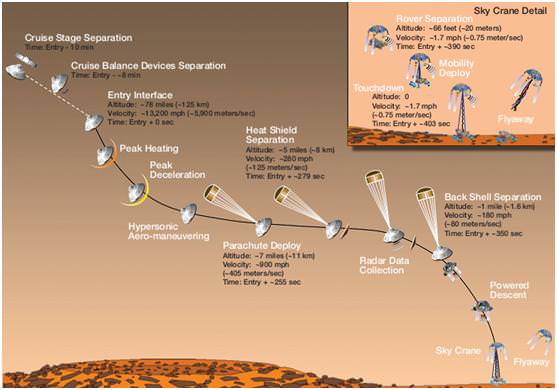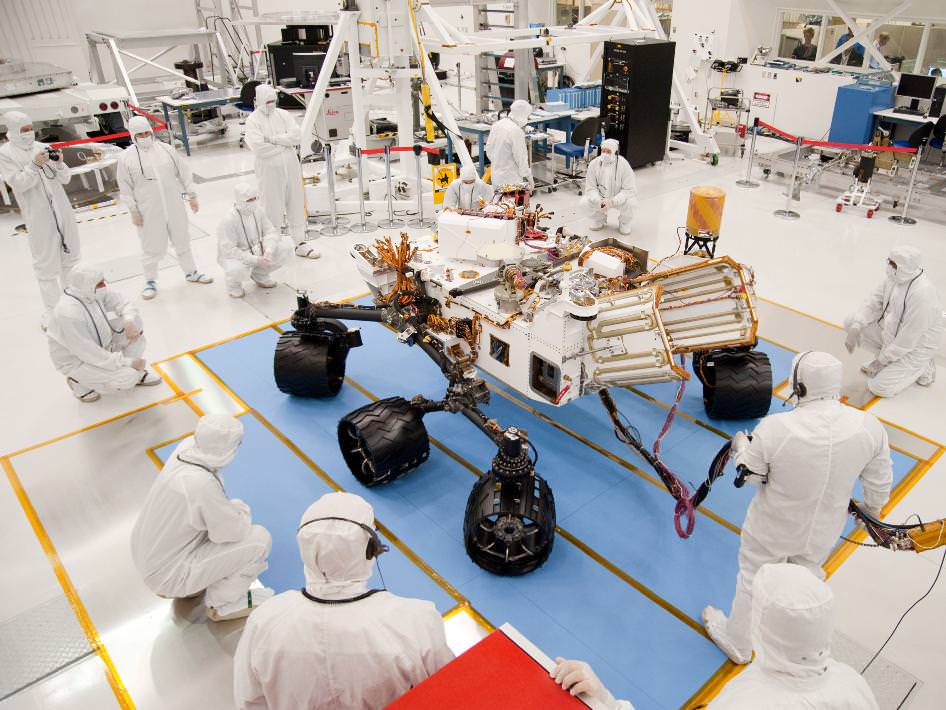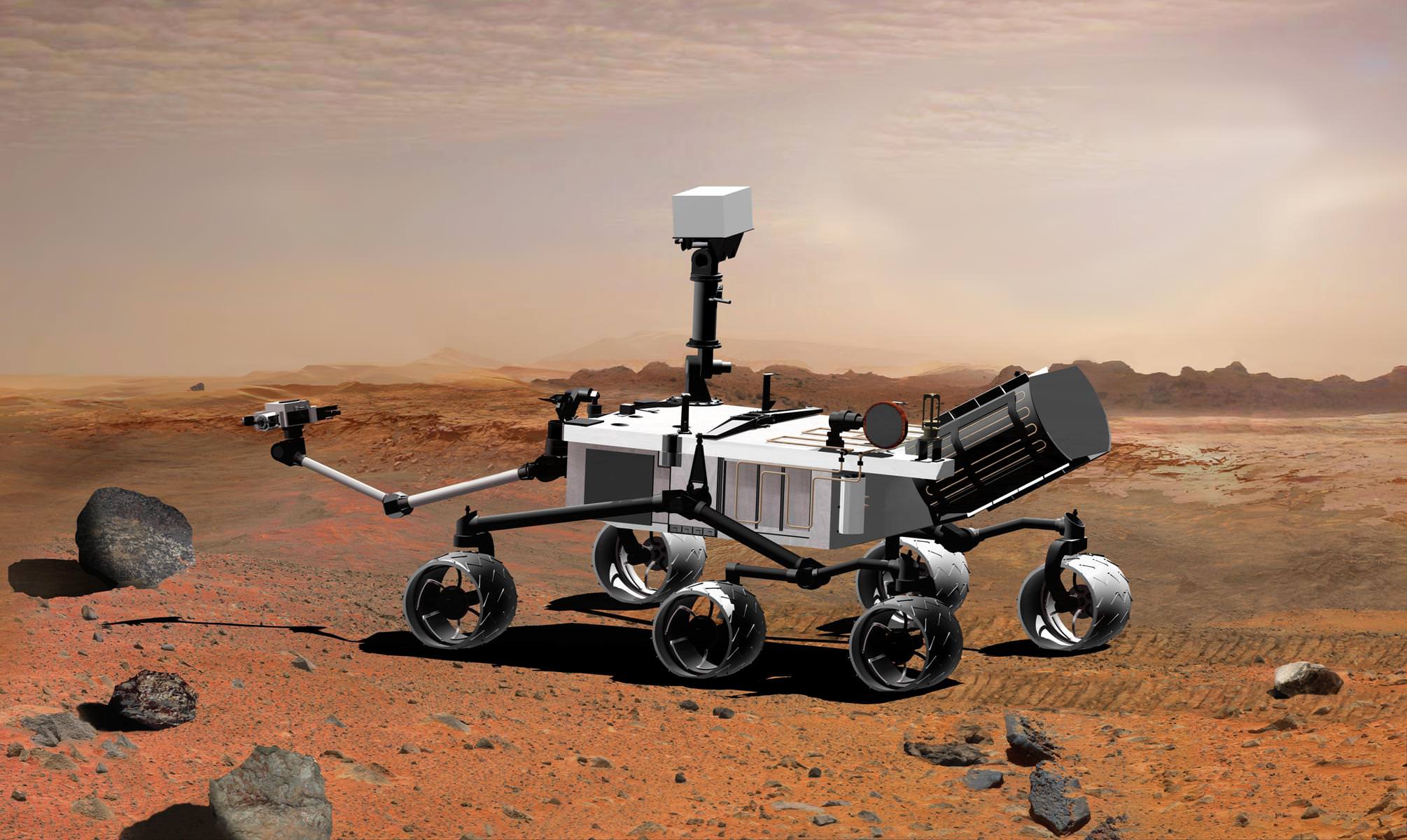NASA Holding Big Events for Curiosity Rover Landing; Register for Chance to Attend
It’s a big rover, so nothing but a big event is appropriate. NASA is going to hold the first-ever multi-center “Social” (formerly known as Tweetups) in conjunction with the landing of the Mars Science Laboratory’s Curiosity rover on Aug. 6 EDT (Aug. 5 PDT). In case you’re not familiar, NASA Socials are in-person meetings with people who engage with the agency through Twitter, Facebook, Google+ and other social networks.
You can register to attend events at one of six NASA centers: Ames Research Center in Moffett Field, Calif.; Glenn Research Center in Cleveland; Goddard Space Flight Center in Greenbelt, Md.; Johnson Space Center in Houston; Langley Research Center in Hampton, Va.; and Jet Propulsion Laboratory (JPL) in Pasadena, Calif. JPL will be having the main event, and each of the other centers will be connected via a multi-center NASA Television simulcast with JPL, home of the Curiosity rover.
If you live close to any of these centers or are willing to travel, and are at all even remotely interested in space exploration, you should register for the chance to attend. Tweetups NASA Socials are incredible events (some attendees have called them life-altering) where you get behind-the-scenes looks at the centers, tours that aren’t normally given to the public, and presentations by scientists, engineers and managers. The events also will provide guests the opportunity to interact with fellow social media users, space enthusiasts and members of NASA’s social media team. Participants will learn about the Mars Science Laboratory mission and their respective NASA field center. They are encouraged to share their experience with others through their favorite social networks.
Registration for the five new NASA Socials opens at noon EDT, Friday, June 29, and closes at noon Tuesday, July 3. NASA randomly will select participants from online registrations. People may register for NASA Socials to be held at multiple locations, but selectees will be chosen for one event only. Each field center’s social and number of guests allowed varies. For more information on each center’s activities and rules pertaining to NASA Social registration, visit:
http://www.nasa.gov/social
Curiosity is currently scheduled to land at Mars’ Gale crater at approximately 1:31 a.m. EDT Aug. 6 (10:31 p.m. PDT Aug. 5), so be prepared to stay up late! But it should be worth it.
During the two-year prime mission, the rover will investigate whether the selected area of Mars offered environmental conditions favorable for microbial life or if evidence of it existed. Find out more about MSL at this website: http://www.nasa.gov/msl
Curiosity and the Issue of Planetary Protection
Curiosity at Centre of Attention During Testing Image Credit: NASA /JPL – Caltech
There have been many reports about the possibility of NASA’s Curiosity rover contaminating Mars with microbes from Earth once it lands on the Red Planet in August. The wheels, the landing procedure and the drill bits have all come under scrutiny. But what are the concerns and what safeguards are there to prevent contamination from this or other missions?
In 1967 the United Nations drew up the ‘Treaty on Principles Governing the Activities of States in the Exploration and Use of Outer Space, Including the Moon and Other Bodies.’ All countries which sign up to the treaty “shall pursue studies of outer space, including the moon and other celestial bodies, and conduct exploration of them so as to avoid their harmful contamination.” Every mission is given a category (I,II,III,IV or V) depending on whether it is a flyby, orbiter, lander, or Earth return mission, whether its destination is a planet, moon, comet, or asteroid and whether the destination could provide clues about life or have the potential to support Earth life. So for instance Cassini is a catagory II mission, Curiosity is classed as a IVc mission.
Every stage of a mission is carefully monitored. From construction in a sterile clean room with laminar-air-flow systems, pressurized microbial barriers and personnel wearing hoods, masks, surgical gloves, booties and protective suits called bunny suits. Components and entire spacecraft are sterilized using dry heat microbial reduction, by being enclosed in a bioshield (like a large casserole dish) and baked them in an oven at 111.7 degrees Celsius for 30 hours. For more sensitive components a low-temperature process is used. Components are placed in a vacuum and hydrogen peroxide is injected into the sterilization chamber to establish a specified vapor concentration. Thousands of samples are taken at every stage of construction and tested for spore-forming organisms, for example the Viking mission in 1975 tested more than 6000 samples in total.
Three issues have arisen with the Curiosity rover. During the landing procedure a parachute and thrusters will slow the descent before the ‘sky crane’ lowers the rover, its wheels making direct contact with the surface. Previous rovers have waited on landing platforms for days before their wheels made contact with the surface and in tests it has been shown that even a few hours exposure to Martian levels of ultraviolet can kill between 81 and 96 per cent of bacteria that may be present. So once Curiosity lands it will probably need to remain stationary for some days to minimize the risk of contamination from its wheels.
Another issue arose last year, after launch, when it was realized that a step in the planetary protection measures wasn’t adhered to during the manufacture of the rover’s drill bits. These were meant to arrive at Mars inside a sterile box, but the box was opened and the bits tested for contamination and one of the bits was attached to the drill head. This procedure strayed from earlier agreed-to protocols. The drills have now become another cause concern as it has been found that Teflon and molybdenum disulfide from seals within the drill assembly could rub off and mix in to contaminate samples excavated during operation, making the samples more difficult to analyze. The MSL team are looking at ways to work around the problem, these could include running the drill on a slower, less percussive setting or dispensing with the drill altogether and relying on Curiosity’s scoop to take soils soil samples and using the rover’s wheels to roll over and break open rocks.
This all serves to highlight the importance of the planetary protection treaty to ensure we do everything possible to reduce the risk of contaminating other worlds and of compromising any data we return.
Find out more at NASA’s Office of Planetary Protection
Engineers Able to Narrow Landing Ellipse for Curiosity Rover
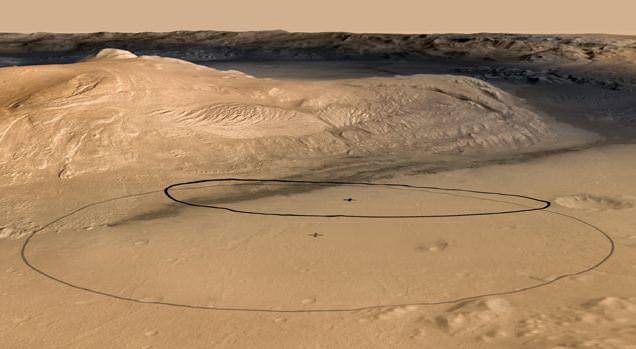
[/caption]
Engineers for the Mars Science Laboratory Curiosity rover have now zeroed in to a more precise landing ellipse, now aiming for a landing spot that is closer to where the scientists ultimately want to be, the foot of Mount Sharp in the center of Gale Crater. It was possible to adjust landing plans because of increased confidence in precision landing technology.
“We’re trimming the distance we’ll have to drive after landing by almost half,” said Pete Theisinger, Mars Science Laboratory project manager at NASA’s Jet Propulsion Laboratory. “That could get us to the mountain months earlier.”
The layers of rock and sediments located in the mountain are the prime location for research with the rover.
Curiosity is scheduled to land at approximately 10:31 p.m. PDT Aug. 5 (1:31 a.m. EDT, Aug. 6). Following checkout operations, Curiosity will begin a two-year study of whether the landing vicinity ever offered an environment favorable for microbial life.
Theisinger and other mission leaders described the target adjustment during an update to reporters on Monday, June 11, about preparations for landing and for operating Curiosity on Mars.
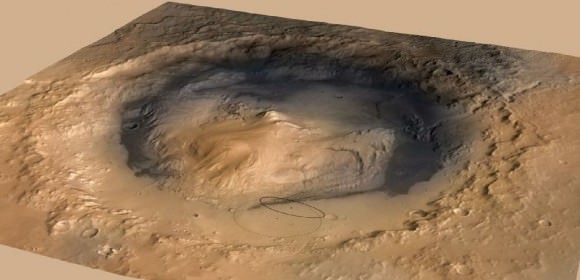
The landing target ellipse had been approximately 20 kilometers wide by 25 kilometers long (12 miles wide and 16 miles long). Continuing analysis of the new landing system’s capabilities has allowed mission planners to shrink the area to approximately 7 by 20 kilometers (4 by 12 miles), assuming winds and other atmospheric conditions are as predicted.
Even with the smaller ellipse, Curiosity will be able to touch down at a safe distance from steep slopes at the edge of Mount Sharp.
“We have been preparing for years for a successful landing by Curiosity, and all signs are good,” said Dave Lavery, Mars Science Laboratory program executive at NASA. “However, landing on Mars always carries risks, so success is not guaranteed. Once on the ground we’ll proceed carefully. We have plenty of time since Curiosity is not as life-limited as the approximate 90-day missions like NASA’s Mars Exploration Rovers and the Phoenix lander.”
Since the spacecraft was launched in November 2011, engineers have continued testing and improving its landing software. Mars Science Laboratory will use an upgraded version of flight software installed on its computers during the past two weeks. Additional upgrades for Mars surface operations will be sent to the rover about a week after landing.
Other preparations include upgrades to the rover’s software and understanding effects of debris coming from the drill the rover will use to collect samples from rocks on Mars. Experiments at JPL indicate that Teflon from the drill could mix with the powdered samples. Testing will continue past landing with copies of the drill. The rover will deliver the samples to onboard instruments that can identify mineral and chemical ingredients.
“The material from the drill could complicate, but will not prevent analysis of carbon content in rocks by one of the rover’s 10 instruments. There are workarounds,” said John Grotzinger, the mission’s project scientist at the California Institute of Technology in Pasadena. “Organic carbon compounds in an environment are one prerequisite for life. We know meteorites deliver non-biological organic carbon to Mars, but not whether it persists near the surface. We will be checking for that and for other chemical and mineral clues about habitability.”
source: JPL
Take a Peek Inside Curiosity’s Shell
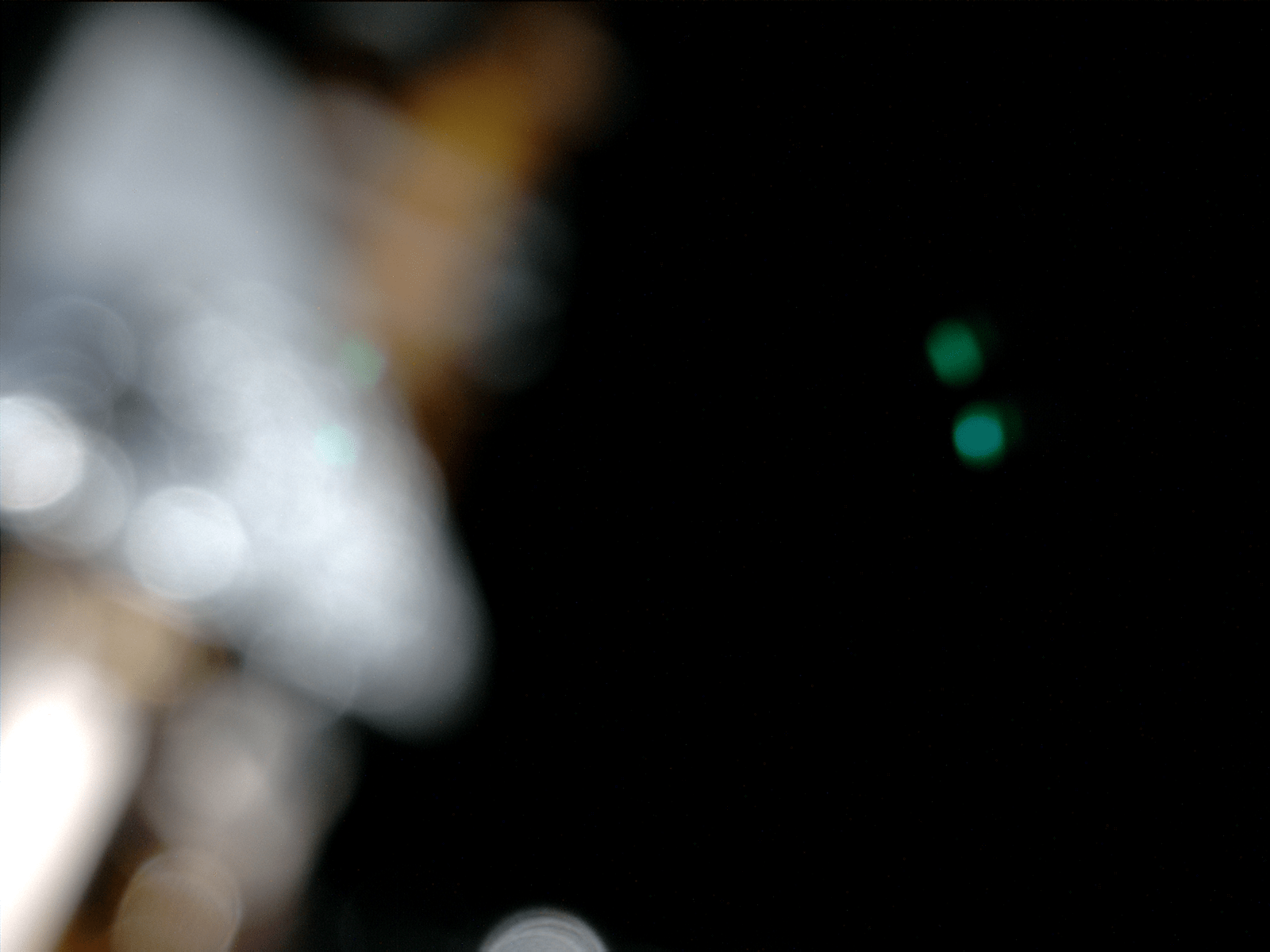
[/caption]
Take a look around Curiosity’s cozy cabin! Ok, there’s really not much to see (she didn’t get a window seat) but when the image above was taken by the rover’s Mars Hand Lens Imager (MAHLI) camera on April 20, the spacecraft she’s tucked into was just over 120 million km (74 million miles) from Earth, en route to Mars. In other words, just past those blurry components and outside that dark shell is real outer space… that’s cool!
This color image was planned by the MSL team, used to confirm that MAHLI is operating as it should. The two green dots are reflections of the camera’s LED lights, and the rusty-orange out-of-focus parts are cables. The silver thing is a bracket holding said cables.
So why is this fancy camera taking blurry pictures (and the folks at NASA are happy about it?) Since MAHLI is designed to take both close-up images of rocks on Mars as well as landscape shots, it has a focusing motor. But when it’s not in use — such as during its current 11-month-long cruise to Mars — the motor puts the focusing lens into a safe position to protect it from damage during launch, entry and landing.
Positioned this way, MAHLI can only focus on objects 2 cm (less than an inch) away from its lens, and there simply aren’t any inside the capsule.
Of course, once Curiosity arrives at Mars and completes her exciting landing at Gale Crater, MAHLI will have plenty of things to take pictures of! Until then we’ll be patient, it can take a rest and we can rest assured that it’s working just fine.
Keep up with the latest news from the Mars Science Laboratory team here.
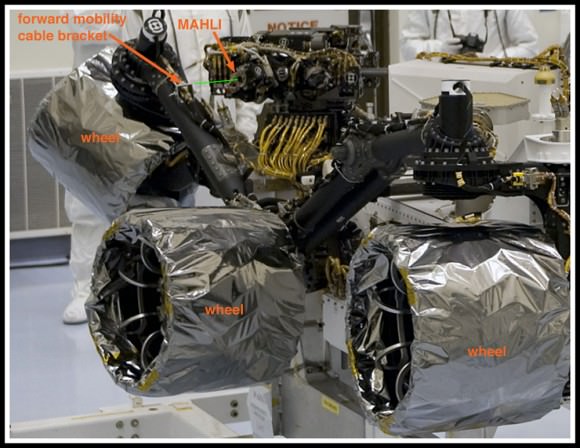
San Diego-based Malin Space Science Systems (MSSS) built and operates the Mars Hand Lens Imager (MAHLI) aboard the Curiosity Mars rover. MSSS also built and operates the rover’s Mastcams and Mars Descent Imager. Read more about their contributions to Curiosity’s exploration mission here.
SAM: NASA’s Attempt to Repeat Viking’s Search for Martian Organics
[/caption]
After 36 years of debate, confusion, and failed attempts by other space agencies to answer a basic question, NASA’s Mars Science Laboratory (MSL) is on its way to repeat the search for organic matter that eluded the two Viking probes.
With 96 days left until landing, MSL will touch down at the Gale Crater this August. The rover, called Curiosity, will be the largest vehicle delivered to our neighboring planet thus far. Weighing in at 900 kg, Curiosity is nearly five times as large as the Spirit and Opportunity rovers that landed eight years ago, and more than 1.5 times as large as each Viking lander that arrived on planet in 1976.
Like the Vikings and Mars Exploration Rovers, Curiosity was conceived and launched, largely to gather information that may tell us whether the Red Planet harbors microbial life. Instrumentation launched for in situ analysis has been advancing steadily since the Viking era, yet each chapter in the story of the search for Martian life builds upon the previous ones.
Though usually mentioned only briefly in the days when Spirit and Opportunity were making headlines, the twin Viking landers were amazing craft, not only for their time, but even for today. The instrument suite of each Viking lander included a suite of three biology experiments, instruments designed for the direct detection of microbes, should the regolith at either of the two Viking landing sites contain any. While subsequent landing craft have carried instruments designed to assess Mars’ potential for life, none since the Project Viking has been built to look for Martian life forms directly.
According to Viking investigator Gilbert Levin, the Viking landers already discovered Martian life. Back in 1976-1977, Levin’s instrument, known as the Labeled Release (LR) experiment, yielded positive results at Chryse Planitia and Utopia Planitia, the two Viking landing sites. When treated with a solution containing small, organic chemicals labeled with radioactive carbon, regolith samples taken at the landing sites released a gas, indicated by an increase in radioactivity in the space above the sample.
While Levin believes the gas is carbon dioxide resulting from the oxidation of the organic chemicals, it’s also conceivable that the chemicals were reduced to another gas, methane. Either way, since heating the samples to a temperature high enough to kill most of the microbes that we know on Earth prevented the gas release, the Viking science team concluded initially that the LR had detected life.
Most of the science team, but not Levin, decided that the gas release in the LR must have resulted from a non-biological chemical reaction. This rethinking was due to variety of factors, but the most important of which was that the gas chromatograph-mass spectrometer (GC-MS) of each lander failed to detect organic matter in the samples. As the late Carl Sagan explained it on his television series, Cosmos, “If there is life on Mars, where are the dead bodies?”
While most astrobiologists and planetary scientists do not agree with Levin that the results of his 36 year-old experiment constitute conclusive evidence for Martian life, there is a growing number of Mars scientists who are equivocal on the issue. According to Levin, Sagan moved into the equivocal category in 1996, after astrobiologist David McKay and colleagues published a paper in the journal Science describing fossilized life in meteorite ALH84001, one of a handful of meteorites known to be from Mars.
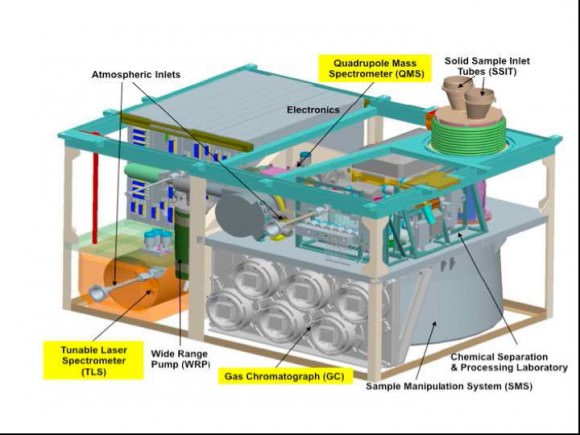
Traveling within Curiosity’s enormous instrument package is a suite of machines called SAM, which stands for “Sample Analysis at Mars”. After all of these years, SAM represents NASA’s first attempt to repeat Viking’s search for Martian organics, but with more advanced technology.
This is not to say that other attempts were not made during the intervening years. In 1996, the Russian Federal Space Agency launched a Mars-bound probe carrying not only organic chemistry equipment but an upgraded version of Levin’s experiment. Rather than treating regolith samples with a mixture of “right-handed” and “left-handed” forms of organic substrates (known in chemistry as racemic mixtures), the new LR would have treated some samples with a left-handed substrate (L-cysteine) and others with the substrate’s mirror image (D-cysteine).
Had results been the same for L- and D-cysteine, a non-biological mechanism would have seemed all the more likely. However, if the active agent in the Martian regolith favored one compound at the expense of the other, this would indicate life. Even more intriguing: if the active agent favored D-cysteine, it would have suggested an origin of life on Mars separate from the origin of life on Earth, since terrestrial life forms use mostly left-handed amino acids. Such a result would suggest that life originates fairly easily, implying a cosmos teaming with living forms.
But Russia’s Mars ’96 probe crashed in the Pacific Ocean shortly after liftoff. A few years later, the European Space Agency sent Beagle 2 to Mars, carrying an advanced organic detection package, but this probe too was lost.
While Curiosity’s SAM does not include an LR experiment of any sort, it does have organic matter detection capability that can operate in mass spectrometry (MS), or gas chromatography-mass spectrometry (GS-MS) mode. In addition to being able to detect certain classes of organic compounds that the Viking GCMS would have missed in surface material, SAM also is designed to look for methane in the Martian atmosphere. Though atmospheric methane already has been detected already from orbit, detailed measurements of its concentration and fluctuations will help astrobiologists to determine whether the source is methane-producing microorganisms.
Curiosity Halfway to Red Planet Touchdown
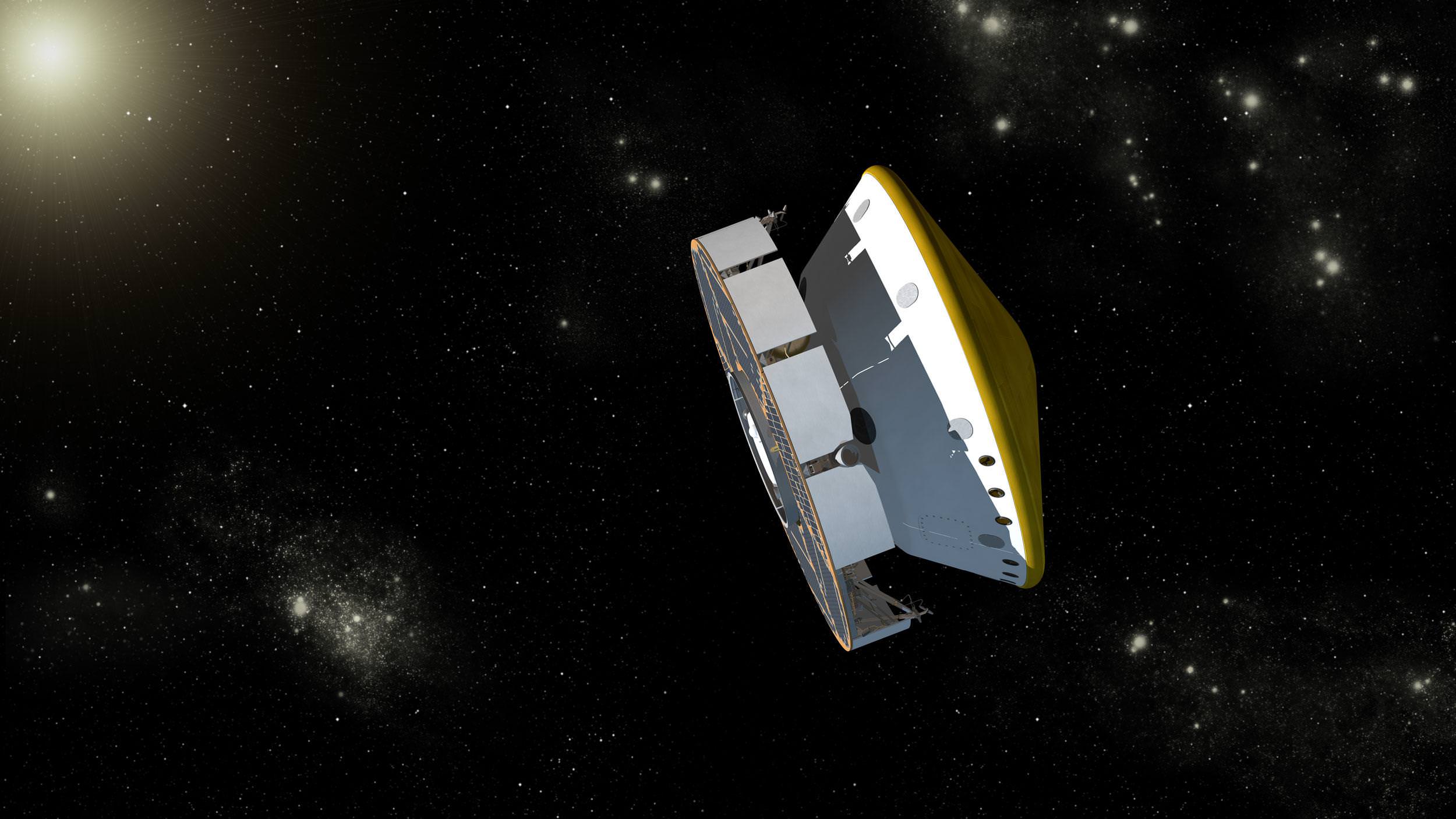
[/caption]
As of today, NASA’s car sized Curiosity rover has reached the halfway point in her 352 million mile (567 million km) journey to Mars – No fooling on April 1, 2012.
It’s T Minus 126 days until Curiosity smashes into the Martian atmosphere to brave the hellish “6 Minutes of Terror” – and, if all goes well, touch down inside Gale Crater at the foothills of a Martian mountain taller than the tallest in the continental United States – namely Mount Rainier.
Curiosity will search for the ingredients of life in the form of organic molecules – the carbon based molecules which are the building blocks of life as we know it. The one-ton behemoth is packed to the gills with 10 state of the art science instruments including a 7 foot long robotic arm, scoop, drill and laser rock zapper.
The Curiosity Mars Science laboratory (MSL) rover was launched from sunny Florida on Nov. 26, 2011 atop a powerful Atlas V rocket for an 8.5 month interplanetary cruise from the Earth to Mars and is on course to land on the Red Planet early in the morning of Aug. 6, 2012 EDT and Universal Time (or Aug. 5 PDT).
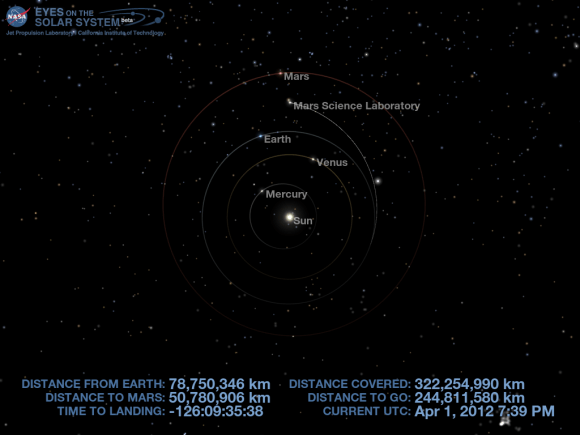
This roadmap shows Curiosity's flight path through the Solar System - From Earth to Mars during the 8.5 month interplanetary cruise. Credit: NASA/JPL-Caltech
On March 26, engineers at NASA’s Jet Propulsion Laboratory, Pasadena, Calif., successfully ignited the spacecrafts thrusters for the second of six planned trajectory correction maneuvers (TCM’s) to adjust the robot’s flight path during the long journey to achieve a pinpoint landing beside the Martian mountain.
“It is satisfying to get the second maneuver under our belts and know we are headed in the right direction,” said JPL’s Erisa Hines, systems lead for the maneuver. “The cruise system continues to perform very well.”
This maneuver was one-seventh as much as the flight’s first course adjustment, on Jan. 11. The cruise stage is equipped with eight thrusters grouped into two sets of four that fire as the entire spacecraft spins at two rotations per minute. The thruster firings change the velocity of the spacecraft in two ways – along the direction of the axis of rotation and also perpendicular to the axis. Altogether there were more than 60 pulsing maneuvers spaced about 10 seconds apart.
“The purpose is to put us on a trajectory to the point in the Mars atmosphere where we need to be for a safe and accurate landing,” said Mau Wong, maneuver analyst at JPL.
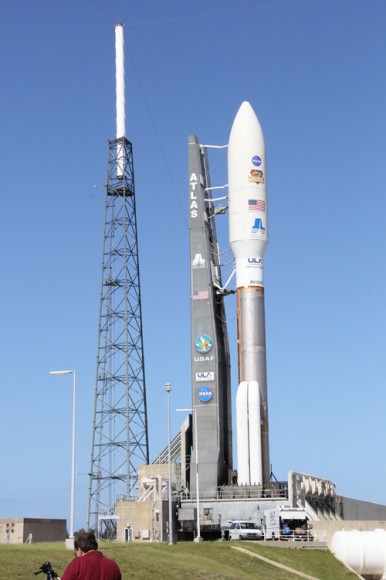
Marking another crucial milestone, the flight team has also powered up and checked the status of all 10 MSL science instruments – and all are nominal.
“The types of testing varied by instrument, and the series as whole takes us past the important milestone of confirming that all the instruments survived launch,” said Betina Pavri of NASA’s Jet Propulsion Laboratory, Pasadena, Calif., science payload test engineer for the mission. “These checkouts provide a valuable calibration and characterization opportunity for the instruments, including camera dark images and a measurement of zero pressure in the vacuum of space for the rover weather station’s pressure sensor.”
Ever since it was the first of MSL’s science instruments to be switched on three months ago, the Radiation Assessment Detector (RAD) has been collecting valuable measurements about the potentially lethal radiation environment in space and acting as a stunt double for determining the potential health effects on future human travelers to Mars.
RAD has been collecting data on the recent wave of extremely powerful solar flares erupting from the sun.
Curiosity has another 244 million kilometers to go over the next 4 months.
All hopes ride on Curiosity as America’s third and last generation of Mars rovers.
Devastating and nonsensical funding cuts to NASA’s Planetary Science budget have forced NASA to cancel participation in the 2018 ExoMars lander mission that had been joint planned with ESA, the European Space Agency. ESA now plans to forge ahead with Russian participation.
Stay tuned
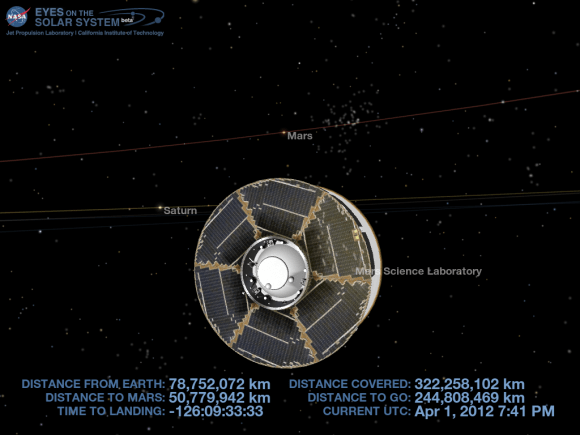
Read Ken’s recent Curiosity feature here:
A Penny for your Curiosity on Mars
NASAs Proposed ‘InSight’ Lander would Peer to the Center of Mars in 2016

[/caption]
A Phoenix-like lander that would mine the deepest hole yet into Mars– to a depth of 5 meters – and unveil the nature of the mysterious deep interior and central core of the Red Planet is under consideration by NASA for a 2016 launch and sports a nifty new name – InSight.
The stationary “InSight” lander would be an international science mission and a near duplicate of NASA’s proven Phoenix spacecraft, Bruce Banerdt told Universe Today. Banerdt is the Principal Investigator of the proposed InSight mission.
“InSight is essentially built from scratch, but nearly build-to-print from the Phoenix design,” Banerdt, of NASA’s Jet Propulsion Laboratory (JPL) in Pasadena , Calif, told me. The team can keep costs down by re-using the blueprints pioneered by Phoenix instead of creating an entirely new spacecraft.
“The robotic arm is similar (but not identical) to the Phoenix arm.”
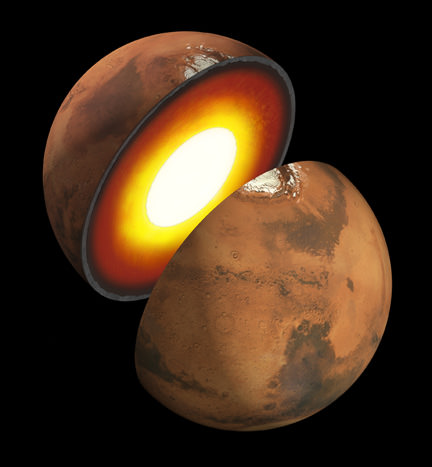
Insight’s goal is to investigate and deduce the nature of the interior of the Red Planet. Credit: JPL/NASA
However, the landing site and science goals for InSight are quite different from Phoenix.
InSight will have an entirely new suite of three science instruments, including two from Europe, designed to peer to the center of Mars and detect the fingerprints of the processes by which the terrestrial planets formed. It will determine if there is any seismic activity, the amount of heat flow from the interior, the size of Mars core and whether the core is liquid or solid.
NASA’s twin GRAIL lunar gravity probes are set to begin their own investigation into the interior and core of Earth’s Moon in early March 2012, and several science team members are common to GRAIL and InSight.
“The seismometer (SEIS, stands for Seismic Experiment for Interior Structure) is from France (built by CNES and IPGP) and the heat flow probe (HP3, stands for Heat flow and Physical Properties Probe) is from Germany (built by DLR),” Banerdt explained.
Phoenix successfully landed in the frigid northern polar regions of Mars in 2008 in search of potential habitats for life and quickly discovered water ice and salty soils that could be favorable for the genesis and support of extraterrestrial life.
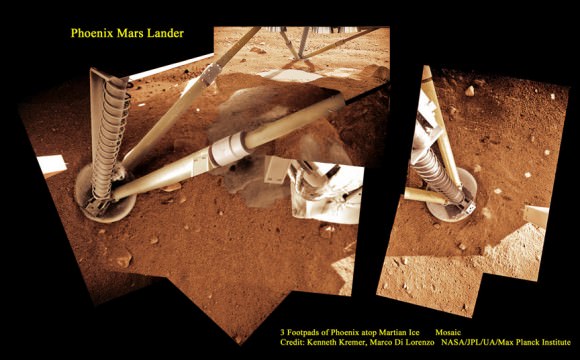
Phoenix thrusters blasted away Martian soil and exposed water ice. Proposed Mars InSight mission will build a new Phoenix-like lander from scratch to peer deep into the Red Planet and investigate the nature and size of the mysterious Martian core. Credit: Kenneth Kremer, Marco Di Lorenzo, Phoenix Mission, NASA/JPL/UA/Max Planck Institute
InSight will intentionally land in a far warmer and sunnier location nearer the moderate climate of the equator to enable a projected lifetime of 2 years (or 1 Mars year) vs. the 5 months survival of Phoenix extremely harsh arctic touchdown zone.
“Our planned landing site is in Elysium Planitia,” Banerdt told me. “It was chosen for optimizing engineering safety margins for landing and power.”
The more equatorial landing site affords far more sun for the life giving solar arrays to power the instruments and electronics.
“We have global objectives and can do our science anywhere on the planet.”
Elysium Planitia is not too far from the landing sites of the Spirit and Curiosity rovers. The Elysium Mons volcano is also in the general area, but it’s a long way from precise site selection.
InSight is a geophysical lander targeted to delve deep beneath the surface into the Martian interior, check its “vital signs”; like “pulse” though seismology, “temperature”, though a heat flow probe, and “reflexes”, through precision tracking.
The purpose is to answer one of science’s most fundamental questions: How were the planets created?
InSight will accomplish much of its science investigations through experiments sitting directly in contact with the Martian surface. The robotic arm will pluck two of the instruments from the lander deck and place them onto Mars.
“The arm will pick the SEIS seismometer and HP3 heat flow probe off the deck and place each on the ground next to the lander. The arm doesn’t have a drill, but the heat flow probe itself will burrow down as deep as 5 meters,” Banerdt elaborated.
The third experiment named RISE (Rotation and Interior Structure Experiment) is to be provided by JPL and will use the spacecraft communication system to provide precise measurements of Mars planetary rotation and elucidate clues to its interior structure and composition.
Right now on Mars, NASA’s Opportunity rover is conducting a Doppler radio tracking experiment similar to what is planned for RISE, but InSight will have a big advantage according to Banerdt.
“The RISE experiment will be very similar to what we are doing right now on Opportunity, but will be able to do much better, said Banerdt. “The differences are that we will get more tracking every week (Opportunity is power-limited during the winter months; that’s why she is currently stationary!) and will make measurements for an entire Mars year – we will likely only get a handful of months from Opportunity.”
Insight will also be equipped with 2 cameras and make some weather measurements.
“We have a camera on the arm and one fixed to the deck, both primarily to support placing the instruments on the surface, although they will be able to scan the landscape around the spacecraft. Both are Black & White,” Banerdt told me.
“We will measure pressure, temperature and wind, mostly to support noise analysis on the seismic data, but will also supply information on the weather.”
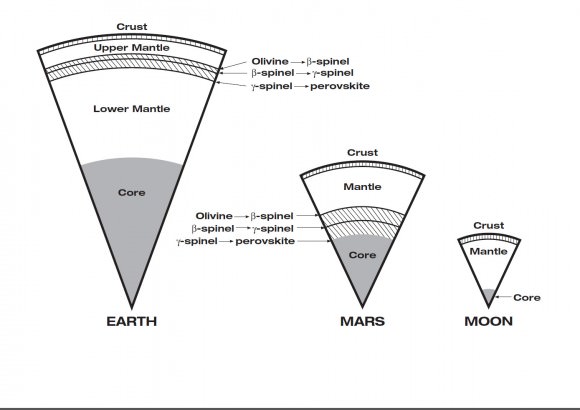
InSight is one of three missions vying to be selected for flight in NASA’s Discovery Program, a series of low cost NASA missions to understand the solar system by exploring planets, moons, and small bodies such as comets and asteroids. All three mission teams are required to submit concept study reports to NASA on March 19.
Banerdt’s team is working hard to finalize the concept study report.
“It describes the mission design as we have refined it over the past 9 months since the NASA Step-1 selection.”
So there is no guarantee that InSight will fly. Because of severe budget cuts to NASA’s Planetary Science Division, NASA had to cancel its scheduled participation in two other Mars missions dubbed ExoMars and jointed planned with ESA, the European Space Agency, for launch in 2016 and 2018.
A Penny for your Curiosity on Mars
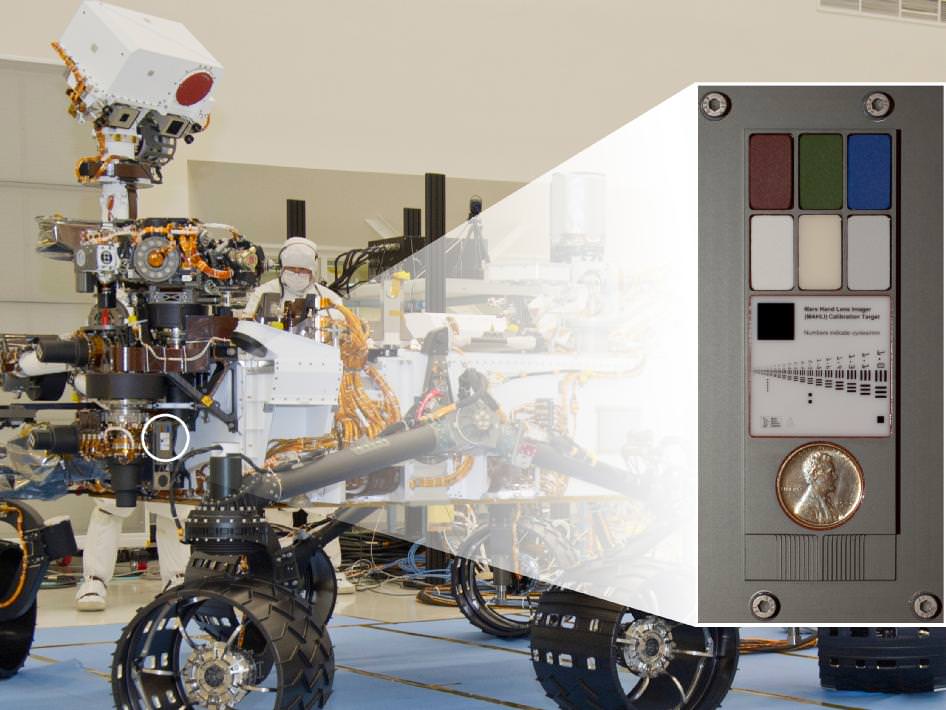
[/caption]
NASA’s huge Curiosity Mars Science Lab (MSL) rover is carrying a vintage Lincoln penny along for the long interplanetary journey to Mars – and it’s not to open the first Martian savings account.
Scientists will use the century old Lincoln penny – minted back in 1909 – as a modern age calibration target for one of Curiosity’s five powerful science cameras attached to the end of the hefty, 7 foot (2.1 meter) long robotic arm.
The car sized rover is on course to touchdown at the foothills of a towering and layered mountain inside Gale Crater in just 161 days on Aug. 6, 2012.
So far Curiosity has traveled 244 million kilometers since blasting off on Nov. 26, 2011 from Florida and has another 322 million kilometers to go to the Red Planet.
The copper penny is bundled to a shoulder joint on the rovers arm along with the other elements of the calibration target, including color chips, a metric standardized bar graphic, and a stair-step pattern for depth calibration.
The whole target is about the size of a smart phone and looks a lot like an eye vision chart in an ophthalmologist’s office. And it serves a similar purpose, which will be to check the performance of Curiosity eyes – specifically the Mars Hand Lens Imager (MAHLI) camera located at the terminus of the robotic arm.
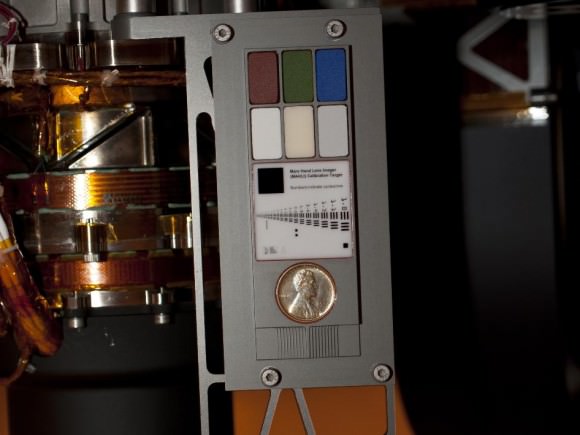
Two instruments at the end of the robotic arm on NASA's Mars rover Curiosity will use calibration targets attached to a shoulder joint of the arm. Credit: NASA/JPL-Caltech
MAHLI will conduct close-up inspections of Martian rocks and soil. It can show tiny details, finer than a human hair.
The term “hand lens” in MAHLI’s name refers to the standard practice by field geologists’ of carrying a hand lens during expeditions for close up, magnified inspection of rocks they find along the way. So it’s also critical to pack various means of calibration so that researchers can interpret their results and put them into proper perspective.
MAHLI can also focus on targets over a wide range of distances near and far, from about a finger’s-width away out to the Red Planets horizon, which in this case means the mountains and rim of the breathtaking Gale Crater landing site.
“When a geologist takes pictures of rock outcrops she is studying, she wants an object of known scale in the photographs,” said MAHLI Principal Investigator Ken Edgett, of Malin Space Science Systems, San Diego, which supplied the camera to NASA.
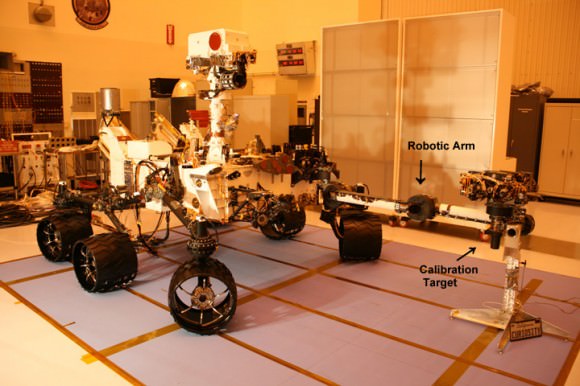
Curiosity with robotic arm extended. Calibration target is located at a shoulder joint on the arm. Photo taken just before encapsulation for 8 month long interplanetary Martian Journey and touchdown inside Gale Crater. Credit: Ken Kremer
The target features a collection of marked black bars in a wide range of labeled sizes to correlate calibration images to each image taken by Curiosity.
“If it is a whole cliff face, she’ll ask a person to stand in the shot. If it is a view from a meter or so away, she might use a rock hammer. If it is a close-up, as the MAHLI can take, she might pull something small out of her pocket. Like a penny.”
Edgett donated the special Lincoln penny with funds from his own pocket. The 1909 “VDB” cent stems from the very first year that Lincoln pennies were minted and also marks the centennial of President Abraham Lincoln’s birth. The VDB initials of the coin’s designer – Victor David Brenner — are on the reverse side. In mint condition the 1909 Lincoln VDB copper penny has a value of about $20.
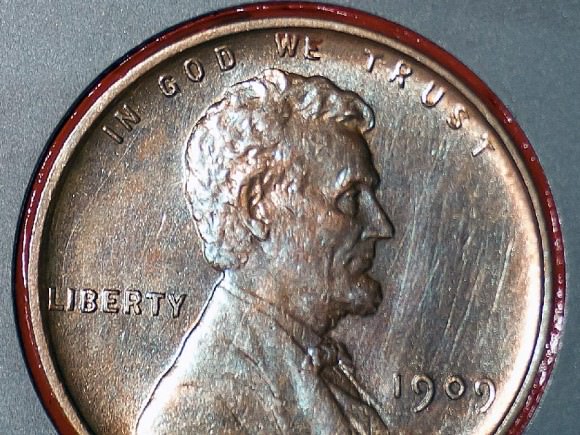
“The penny is on the MAHLI calibration target as a tip of the hat to geologists’ informal practice of placing a coin or other object of known scale in their photographs. A more formal practice is to use an object with scale marked in millimeters, centimeters or meters,” Edgett said. “Of course, this penny can’t be moved around and placed in MAHLI images; it stays affixed to the rover.”
“Everyone in the United States can recognize the penny and immediately know how big it is, and can compare that with the rover hardware and Mars materials in the same image,” Edgett said.
“The public can watch for changes in the penny over the long term on Mars. Will it change color? Will it corrode? Will it get pitted by windblown sand?”
MAHLI’s calibration target also features a display of six patches of pigmented silicone to assist in interpreting color and brightness in the images. Five of them are leftovers from Spirit and Opportunity. The sixth has a fluorescent pigment that glows red when exposed to ultraviolet light, allows checking of an ultraviolet light source on MAHLI. The fluorescent material was donated to the MAHLI team by Spectra Systems, Inc., Providence, R.I.
Three-dimensional calibration of the MSL images will be done using the penny and a stair-stepped area at the bottom of the target.
“The importance of calibration is to allow data acquired on Mars to be compared reliably to data acquired on Earth,” said Mars Science Laboratory Project Scientist John Grotzinger, of the California Institute of Technology, Pasadena.
Curiosity is a 1 ton (900 kg) behemoth. She measures 3 meters (10 ft) in length and is nearly twice the size and five times as heavy as Spirit and Opportunity, NASA’s prior set of twin Martian robots. The science payload is 15 times heavier than the twin robots.
Curiosity is packed to the gills with 10 state of the art science instruments that are seeking the signs of life in the form of organic molecules – the carbon based building blocks of life as we know it.
NASA could only afford to build one rover this time.
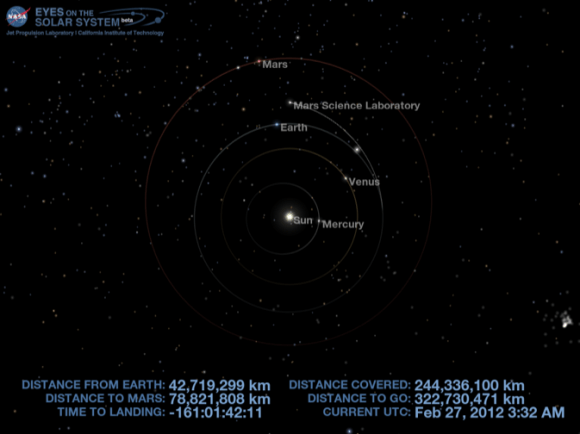
Curiosity will be NASA’s last Mars rover since the 4th generation ExoMars rover due to liftoff in 2018 was just cancelled by the Obama Administration as part of a deep slash to NASA’s Planetary Science budget.
Curiosity Rover Acting as Stunt Double for Humans
En route to the Red Planet, Mars rover Curiosity has experienced the strongest solar radiation storm since 2005. No need to be alarmed: Researchers say it’s all part of Curiosity’s job as a ‘stunt double’ for human astronauts.

